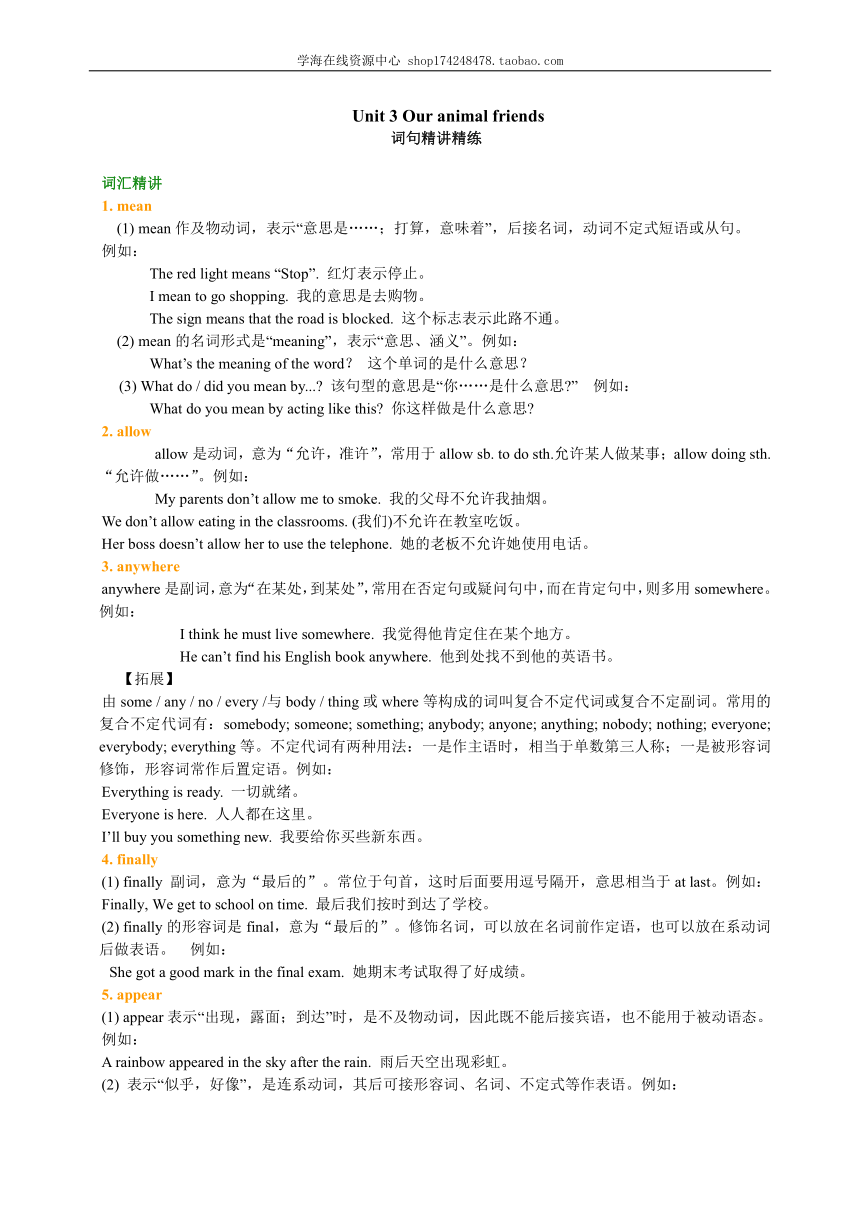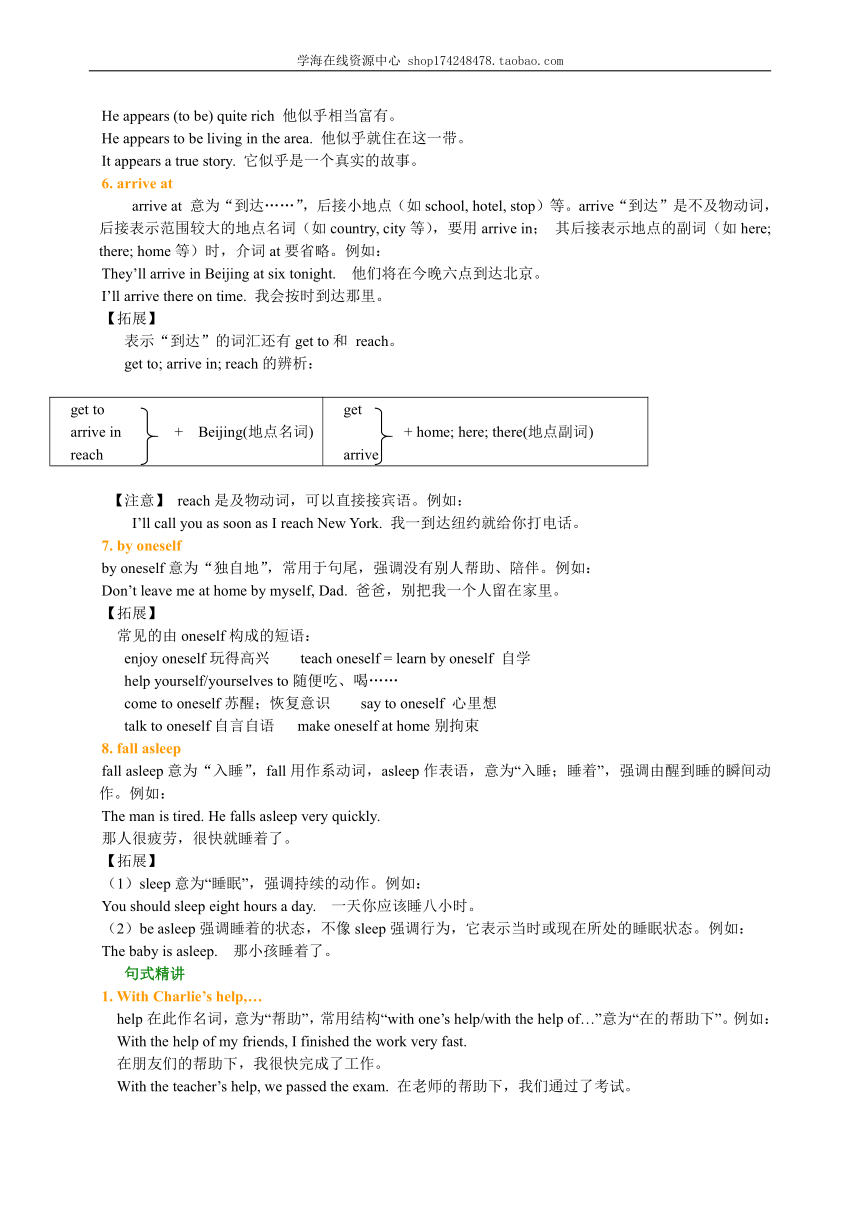Module 2 Man's best friends Unit 3 Our animal friends知识讲解
文档属性
| 名称 | Module 2 Man's best friends Unit 3 Our animal friends知识讲解 |

|
|
| 格式 | doc | ||
| 文件大小 | 38.0KB | ||
| 资源类型 | 教案 | ||
| 版本资源 | 牛津深圳版 | ||
| 科目 | 英语 | ||
| 更新时间 | 2023-07-12 08:59:24 | ||
图片预览


文档简介
学海在线资源中心 shop174248478.
Unit 3 Our animal friends
词句精讲精练
词汇精讲
1. mean
(1) mean作及物动词,表示“意思是……;打算,意味着”,后接名词,动词不定式短语或从句。
例如:
The red light means “Stop”. 红灯表示停止。
I mean to go shopping. 我的意思是去购物。
The sign means that the road is blocked. 这个标志表示此路不通。
(2) mean的名词形式是“meaning”,表示“意思、涵义”。例如:
What’s the meaning of the word? 这个单词的是什么意思?
(3) What do / did you mean by... 该句型的意思是“你……是什么意思 ” 例如:
What do you mean by acting like this 你这样做是什么意思
2. allow
allow是动词,意为“允许,准许”,常用于allow sb. to do sth.允许某人做某事;allow doing sth.“允许做……”。例如:
My parents don’t allow me to smoke. 我的父母不允许我抽烟。
We don’t allow eating in the classrooms. (我们)不允许在教室吃饭。
Her boss doesn’t allow her to use the telephone. 她的老板不允许她使用电话。
3. anywhere
anywhere是副词,意为“在某处,到某处”,常用在否定句或疑问句中,而在肯定句中,则多用somewhere。例如:
I think he must live somewhere. 我觉得他肯定住在某个地方。
He can’t find his English book anywhere. 他到处找不到他的英语书。
【拓展】
由some / any / no / every /与body / thing或where等构成的词叫复合不定代词或复合不定副词。常用的复合不定代词有:somebody; someone; something; anybody; anyone; anything; nobody; nothing; everyone; everybody; everything等。不定代词有两种用法:一是作主语时,相当于单数第三人称;一是被形容词修饰,形容词常作后置定语。例如:
Everything is ready. 一切就绪。
Everyone is here. 人人都在这里。
I’ll buy you something new. 我要给你买些新东西。
4. finally
(1) finally 副词,意为“最后的”。常位于句首,这时后面要用逗号隔开,意思相当于at last。例如:
Finally, We get to school on time. 最后我们按时到达了学校。
(2) finally的形容词是final,意为“最后的”。修饰名词,可以放在名词前作定语,也可以放在系动词后做表语。 例如:
She got a good mark in the final exam. 她期末考试取得了好成绩。
5. appear
(1) appear表示“出现,露面;到达”时,是不及物动词,因此既不能后接宾语,也不能用于被动语态。
例如:
A rainbow appeared in the sky after the rain. 雨后天空出现彩虹。
(2) 表示“似乎,好像”,是连系动词,其后可接形容词、名词、不定式等作表语。例如:
He appears (to be) quite rich 他似乎相当富有。
He appears to be living in the area. 他似乎就住在这一带。
It appears a true story. 它似乎是一个真实的故事。
6. arrive at
arrive at 意为“到达……”,后接小地点(如school, hotel, stop)等。arrive“到达”是不及物动词,后接表示范围较大的地点名词(如country, city等),要用arrive in; 其后接表示地点的副词(如here; there; home等)时,介词at要省略。例如:
They’ll arrive in Beijing at six tonight. 他们将在今晚六点到达北京。
I’ll arrive there on time. 我会按时到达那里。
【拓展】
表示“到达”的词汇还有get to和 reach。
get to; arrive in; reach的辨析:
get toarrive in + Beijing(地点名词)reach get + home; here; there(地点副词)arrive
【注意】 reach是及物动词,可以直接接宾语。例如:
I’ll call you as soon as I reach New York. 我一到达纽约就给你打电话。
7. by oneself
by oneself意为“独自地”,常用于句尾,强调没有别人帮助、陪伴。例如:
Don’t leave me at home by myself, Dad. 爸爸,别把我一个人留在家里。
【拓展】
常见的由oneself构成的短语:
enjoy oneself玩得高兴 teach oneself = learn by oneself 自学
help yourself/yourselves to随便吃、喝……
come to oneself苏醒;恢复意识 say to oneself 心里想
talk to oneself自言自语 make oneself at home别拘束
8. fall asleep
fall asleep意为“入睡”,fall用作系动词,asleep作表语,意为“入睡;睡着”,强调由醒到睡的瞬间动作。例如:
The man is tired. He falls asleep very quickly.
那人很疲劳,很快就睡着了。
【拓展】
(1)sleep意为“睡眠”,强调持续的动作。例如:
You should sleep eight hours a day. 一天你应该睡八小时。
(2)be asleep强调睡着的状态,不像sleep强调行为,它表示当时或现在所处的睡眠状态。例如:
The baby is asleep. 那小孩睡着了。
句式精讲
1. With Charlie’s help,…
help在此作名词,意为“帮助”,常用结构“with one’s help/with the help of…”意为“在的帮助下”。例如:
With the help of my friends, I finished the work very fast.
在朋友们的帮助下,我很快完成了工作。
With the teacher’s help, we passed the exam. 在老师的帮助下,我们通过了考试。
【拓展】
help为动词时,意为“帮助”,常用的句式有:
help sb (to) do sth帮助某人做某事
help sb with sth在某方面帮助某人
例如:
I helped her (to) find the bus stop. 我帮她找到了公共汽车站。
Mr. Li often helps us with our English. 李老师经常帮我们学习英语。
2. You’d better look after him …
had better(常简略为’d better)是一固定词组,had better意为“最好”,用于表示对别人的劝告、建议或表示一种愿望。其用法有以下几点:
(1) had better后面必须跟动词原形,构成had better do sth.句型。例如:
You’d better go to hospital at once.你最好立即去医院看病。
Tom, you’d better go there today.汤姆,你最好今天去那里。
(2) 主语不论是第几人称,句子不论是什么时态,都要用had better的形式。例如:
Now you(he; we) had better listen to the teacher.
你(他,我们)现在最好听老师讲。
3. Then I saw something moving towards me.
see sb. / sth. doing sth.意为“看到某人/某物正在做某事”,see后跟动词-ing形式作宾补。例如:
I saw a dog lying on the floor just now. 刚才我看到一条狗躺在地上。
【拓展】
(1) see sb./ sth. doing 与see sb. / sth. do的辨析:
see sb./ sth. doing 强调看到人/物正在做着某事
see sb. / sth. do 不强调看到人/物的动作正在进行
例如:
I saw a bird standing on my desk a moment ago. 我刚才看到一只鸟正站在我的桌子上。
We often see the old woman carry water by herself. 我们经常看到那个老太太自己提水。
(2) 后面跟动词-ing形式作宾补的动词(词组)有:look at; listen to; hear; notice; watch; keep等。
例如:
I heard him playing the piano in the room just now. 我刚才听见他正在房间里弹钢琴。
4. help yourselves to 反身代词
(1) 反身代词的构成
反身代词指代某人自己,单数以-self结尾,复数以-selves结尾。第一、二人称反身代词由形容词性物主代词+self/selves构成,第三人称反身代词由宾格人称代词 + self / selves构成。
数 人称 第一人称 第二人称 第三人称
单数 myself yourself himself; herself; itself
复数 ourselves yourselves themselves
口诀:
反身代词构成并不难,单数词尾-self记心间。
第三人称宾格加在前,其余物主开头用在先。
复数形式如何变,f要用ves来替换。
(2) 反身代词的用法
1) 作宾语
反身代词常用在buy, enjoy, help, hurt, teach, wash等及物动词和by, to, after, for, about等介词后作宾语。例如:
You have to learn to look after yourself. 你得学会照顾自己。(作介词的宾语)
My sister can’t wash herself yet. 我的妹妹还不会自己洗脸。(作动词的宾语)
2) 作同位语
反身代词常作主语或宾语的同位语,起强调作用,表示“自己;亲自”的意思。作主语同位语时,可以放在主语之后,也可以放在句子的末尾;但作宾语同位语时,反身代词只能放在宾语之后。例如:
The tiger himself didn’t often go to look for food. =
The tiger didn’t often go to look for food himself. 老虎自己很少出去寻找食物。(主语同位语)
You’d better ask Mary herself. 你最好问问玛丽本人。(宾语同位语)
3) 作表语
反身代词也常放在系动词之后作表语,表示与主语是同一人或物。例如:
The man in the photo is myself. 照片上的那个人就是我(自己)。
口诀:
反身代词莫乱用,能作句中宾、表、同(宾语、表语、同位语),主语、定语不宜用,固定搭配要记清。
PAGE
Unit 3 Our animal friends
词句精讲精练
词汇精讲
1. mean
(1) mean作及物动词,表示“意思是……;打算,意味着”,后接名词,动词不定式短语或从句。
例如:
The red light means “Stop”. 红灯表示停止。
I mean to go shopping. 我的意思是去购物。
The sign means that the road is blocked. 这个标志表示此路不通。
(2) mean的名词形式是“meaning”,表示“意思、涵义”。例如:
What’s the meaning of the word? 这个单词的是什么意思?
(3) What do / did you mean by... 该句型的意思是“你……是什么意思 ” 例如:
What do you mean by acting like this 你这样做是什么意思
2. allow
allow是动词,意为“允许,准许”,常用于allow sb. to do sth.允许某人做某事;allow doing sth.“允许做……”。例如:
My parents don’t allow me to smoke. 我的父母不允许我抽烟。
We don’t allow eating in the classrooms. (我们)不允许在教室吃饭。
Her boss doesn’t allow her to use the telephone. 她的老板不允许她使用电话。
3. anywhere
anywhere是副词,意为“在某处,到某处”,常用在否定句或疑问句中,而在肯定句中,则多用somewhere。例如:
I think he must live somewhere. 我觉得他肯定住在某个地方。
He can’t find his English book anywhere. 他到处找不到他的英语书。
【拓展】
由some / any / no / every /与body / thing或where等构成的词叫复合不定代词或复合不定副词。常用的复合不定代词有:somebody; someone; something; anybody; anyone; anything; nobody; nothing; everyone; everybody; everything等。不定代词有两种用法:一是作主语时,相当于单数第三人称;一是被形容词修饰,形容词常作后置定语。例如:
Everything is ready. 一切就绪。
Everyone is here. 人人都在这里。
I’ll buy you something new. 我要给你买些新东西。
4. finally
(1) finally 副词,意为“最后的”。常位于句首,这时后面要用逗号隔开,意思相当于at last。例如:
Finally, We get to school on time. 最后我们按时到达了学校。
(2) finally的形容词是final,意为“最后的”。修饰名词,可以放在名词前作定语,也可以放在系动词后做表语。 例如:
She got a good mark in the final exam. 她期末考试取得了好成绩。
5. appear
(1) appear表示“出现,露面;到达”时,是不及物动词,因此既不能后接宾语,也不能用于被动语态。
例如:
A rainbow appeared in the sky after the rain. 雨后天空出现彩虹。
(2) 表示“似乎,好像”,是连系动词,其后可接形容词、名词、不定式等作表语。例如:
He appears (to be) quite rich 他似乎相当富有。
He appears to be living in the area. 他似乎就住在这一带。
It appears a true story. 它似乎是一个真实的故事。
6. arrive at
arrive at 意为“到达……”,后接小地点(如school, hotel, stop)等。arrive“到达”是不及物动词,后接表示范围较大的地点名词(如country, city等),要用arrive in; 其后接表示地点的副词(如here; there; home等)时,介词at要省略。例如:
They’ll arrive in Beijing at six tonight. 他们将在今晚六点到达北京。
I’ll arrive there on time. 我会按时到达那里。
【拓展】
表示“到达”的词汇还有get to和 reach。
get to; arrive in; reach的辨析:
get toarrive in + Beijing(地点名词)reach get + home; here; there(地点副词)arrive
【注意】 reach是及物动词,可以直接接宾语。例如:
I’ll call you as soon as I reach New York. 我一到达纽约就给你打电话。
7. by oneself
by oneself意为“独自地”,常用于句尾,强调没有别人帮助、陪伴。例如:
Don’t leave me at home by myself, Dad. 爸爸,别把我一个人留在家里。
【拓展】
常见的由oneself构成的短语:
enjoy oneself玩得高兴 teach oneself = learn by oneself 自学
help yourself/yourselves to随便吃、喝……
come to oneself苏醒;恢复意识 say to oneself 心里想
talk to oneself自言自语 make oneself at home别拘束
8. fall asleep
fall asleep意为“入睡”,fall用作系动词,asleep作表语,意为“入睡;睡着”,强调由醒到睡的瞬间动作。例如:
The man is tired. He falls asleep very quickly.
那人很疲劳,很快就睡着了。
【拓展】
(1)sleep意为“睡眠”,强调持续的动作。例如:
You should sleep eight hours a day. 一天你应该睡八小时。
(2)be asleep强调睡着的状态,不像sleep强调行为,它表示当时或现在所处的睡眠状态。例如:
The baby is asleep. 那小孩睡着了。
句式精讲
1. With Charlie’s help,…
help在此作名词,意为“帮助”,常用结构“with one’s help/with the help of…”意为“在的帮助下”。例如:
With the help of my friends, I finished the work very fast.
在朋友们的帮助下,我很快完成了工作。
With the teacher’s help, we passed the exam. 在老师的帮助下,我们通过了考试。
【拓展】
help为动词时,意为“帮助”,常用的句式有:
help sb (to) do sth帮助某人做某事
help sb with sth在某方面帮助某人
例如:
I helped her (to) find the bus stop. 我帮她找到了公共汽车站。
Mr. Li often helps us with our English. 李老师经常帮我们学习英语。
2. You’d better look after him …
had better(常简略为’d better)是一固定词组,had better意为“最好”,用于表示对别人的劝告、建议或表示一种愿望。其用法有以下几点:
(1) had better后面必须跟动词原形,构成had better do sth.句型。例如:
You’d better go to hospital at once.你最好立即去医院看病。
Tom, you’d better go there today.汤姆,你最好今天去那里。
(2) 主语不论是第几人称,句子不论是什么时态,都要用had better的形式。例如:
Now you(he; we) had better listen to the teacher.
你(他,我们)现在最好听老师讲。
3. Then I saw something moving towards me.
see sb. / sth. doing sth.意为“看到某人/某物正在做某事”,see后跟动词-ing形式作宾补。例如:
I saw a dog lying on the floor just now. 刚才我看到一条狗躺在地上。
【拓展】
(1) see sb./ sth. doing 与see sb. / sth. do的辨析:
see sb./ sth. doing 强调看到人/物正在做着某事
see sb. / sth. do 不强调看到人/物的动作正在进行
例如:
I saw a bird standing on my desk a moment ago. 我刚才看到一只鸟正站在我的桌子上。
We often see the old woman carry water by herself. 我们经常看到那个老太太自己提水。
(2) 后面跟动词-ing形式作宾补的动词(词组)有:look at; listen to; hear; notice; watch; keep等。
例如:
I heard him playing the piano in the room just now. 我刚才听见他正在房间里弹钢琴。
4. help yourselves to 反身代词
(1) 反身代词的构成
反身代词指代某人自己,单数以-self结尾,复数以-selves结尾。第一、二人称反身代词由形容词性物主代词+self/selves构成,第三人称反身代词由宾格人称代词 + self / selves构成。
数 人称 第一人称 第二人称 第三人称
单数 myself yourself himself; herself; itself
复数 ourselves yourselves themselves
口诀:
反身代词构成并不难,单数词尾-self记心间。
第三人称宾格加在前,其余物主开头用在先。
复数形式如何变,f要用ves来替换。
(2) 反身代词的用法
1) 作宾语
反身代词常用在buy, enjoy, help, hurt, teach, wash等及物动词和by, to, after, for, about等介词后作宾语。例如:
You have to learn to look after yourself. 你得学会照顾自己。(作介词的宾语)
My sister can’t wash herself yet. 我的妹妹还不会自己洗脸。(作动词的宾语)
2) 作同位语
反身代词常作主语或宾语的同位语,起强调作用,表示“自己;亲自”的意思。作主语同位语时,可以放在主语之后,也可以放在句子的末尾;但作宾语同位语时,反身代词只能放在宾语之后。例如:
The tiger himself didn’t often go to look for food. =
The tiger didn’t often go to look for food himself. 老虎自己很少出去寻找食物。(主语同位语)
You’d better ask Mary herself. 你最好问问玛丽本人。(宾语同位语)
3) 作表语
反身代词也常放在系动词之后作表语,表示与主语是同一人或物。例如:
The man in the photo is myself. 照片上的那个人就是我(自己)。
口诀:
反身代词莫乱用,能作句中宾、表、同(宾语、表语、同位语),主语、定语不宜用,固定搭配要记清。
PAGE
